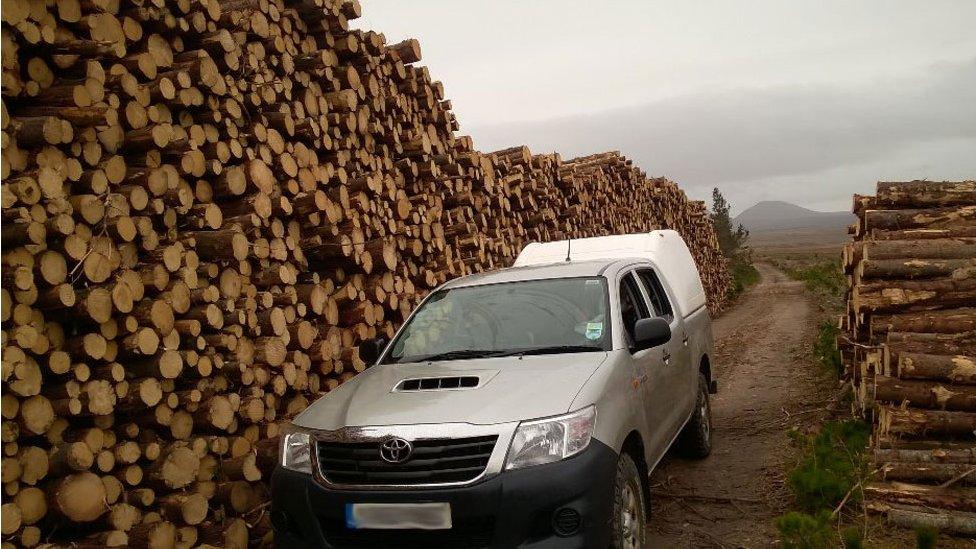The bog swarming with scientists and artists
- Published
Scotland's Flow Country is critical in fighting climate change
The Flow Country is a beautiful but precarious habitat which is critical in the fight against the effects of climate change.
It is widely considered to be the largest area of blanket bog in the world and acts as a giant carbon sink, soaking up huge amounts of the greenhouse gas carbon dioxide (CO2) from the atmosphere.
Dark and dappled, the landscape is of great interest to scientists and more recently to artists, who want to raise awareness of this remarkable place.
At first glance the massive expanse of moorland stretching across Caithness and Sutherland appears featureless but, if you stop and listen, it is teeming with life.

A skylark shimmers towards the heavens, its song spiralling out over the bog. Tadpoles wiggle in peaty water underneath the shadows of skittering pond skaters.
The wind rushes over sphagnum moss and shakes the spiky, sticky sundew, which is slowly digesting the insects it has snared.

At first glance the landscape looks featureless
"Underneath our feet in the flow country there is an estimated 400 million tonnes of carbon," says Dr Roxane Andersen of the Environmental Research Institute at the University of the Highlands and Islands.
That amounts to three times as much carbon than is contained in all the trees in the UK, calculates Dr Andersen, who worries that the bog's role as a carbon sink is under threat.
It is though hard to feel a sense of urgency when you stand in the midst of this wild and beguiling country, which stretches for some 1,500 square miles (4,000 sq km) across the far north of the Scottish mainland.
Standing amidst the black pools, Kathy Hinde is in her element.
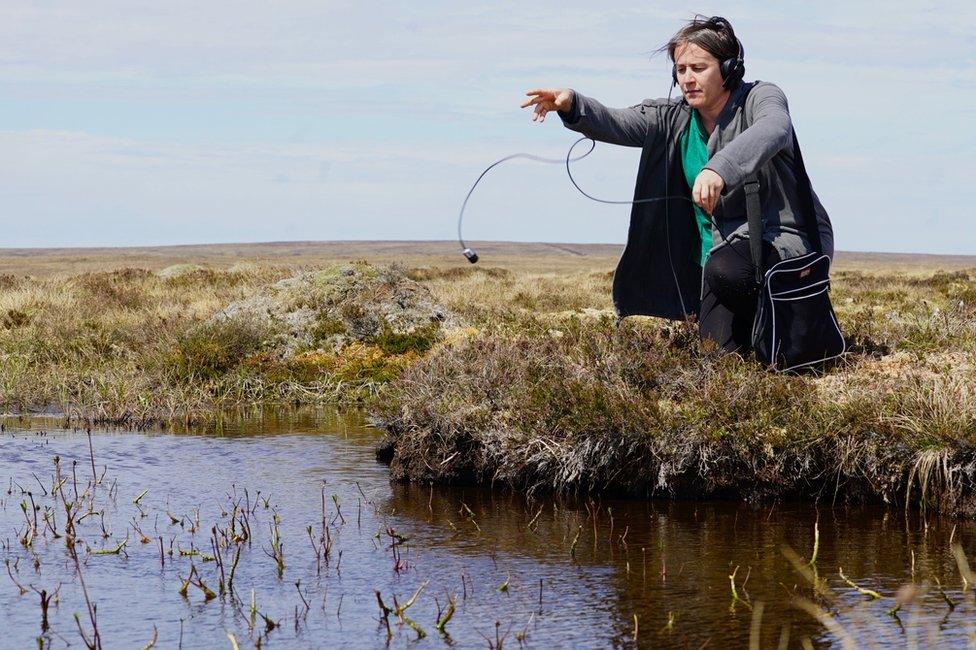
Kathy Hinde uses a hydrophone to record sounds from the bog
Wearing a gentle smile and bedecked with headphones, sound mixer and huge fluffy microphone, Ms Hinde, who describes herself as a visual artist and composer, is capturing it all.
"What I'm really passionate about is trying to connect people with the natural world," says Ms Hinde, who is one of five artists from the Glasgow art house Cryptic who have been working here on the RSPB's Forsinard Flows nature reserve, preparing for a show at this summer's Edinburgh Fringe.

"I've got underwater microphones that I can throw into the bog pools and have a listen. I've also got those hydrophones I can bury into the squelching bog," explains Ms Hinde.
What does she hear?
Aquatic insects such as water boatmen make clicking and popping sounds, she says, while some underwater invertebrates produce "electronic sounding chirps" and others undulate like synthesisers.
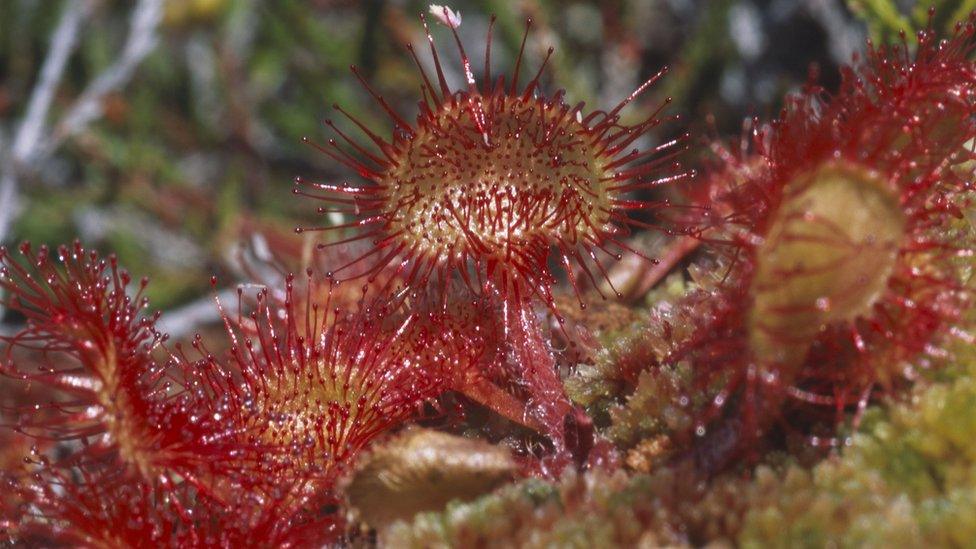
Sundew traps and digests insects
The soundscapes which Ms Hinde will produce from her recordings here, along with a water-powered musical sculpture, will be staged in Edinburgh's Royal Botanic Garden along with installations from the other artists.
Sculptures created by Heather Lander will house microhabitats made of ceramics, ink, paper and paintings.
Visual artist Hannah Imlach will present images referencing the scientific instruments used on the bog. Luci Holland and Matthew Olden will produce soundscapes inspired by natural audio and scientific data gathered here.
On top of these installations the show, entitled Below the Blanket, will feature the premiere of a choral work composed by Malcolm Lindsay and sung by the Dunedin Consort, a baroque ensemble.
The entire project aims to highlight the importance of a habitat which is often forgotten and which has been neglected in the past.
As well as artists and wildlife, the bog is also swarming with scientists.
Between 2015 and 2017 there were 13 doctorates written about it, with much of that research focusing on climate change.
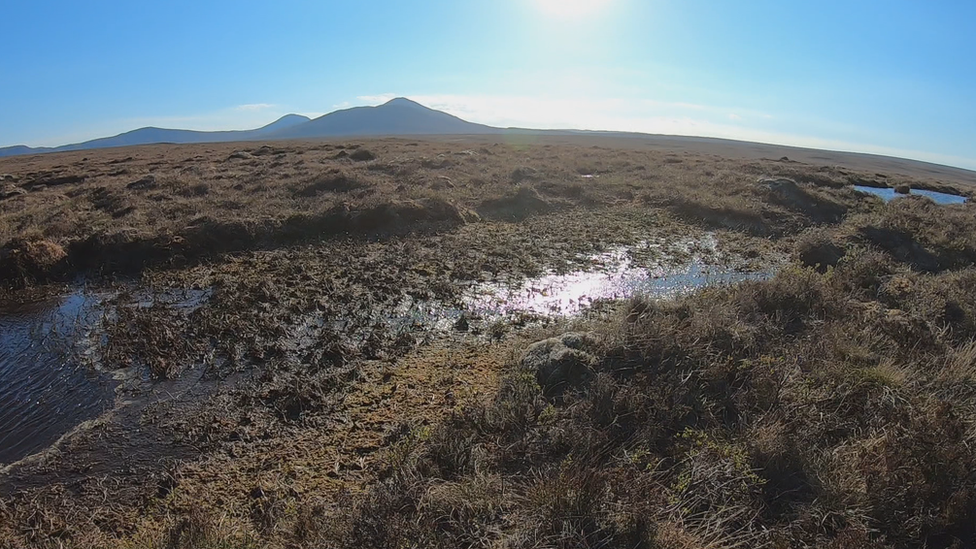
The area has been put forward for world heritage status
An outstanding application for World Heritage Status by the UK government in 2012, describes the Flow Country as "the largest area of blanket bog in the world", external.
"The peat is composed of not-quite-rotted-away remains of plants -and plants, when they're growing, take in carbon through photosynthesis. So that's holding carbon in the peat," explains Caroline Eccles of the RSPB and the Peatlands Partnership, a group which brings together government agencies, charities and educational establishments.
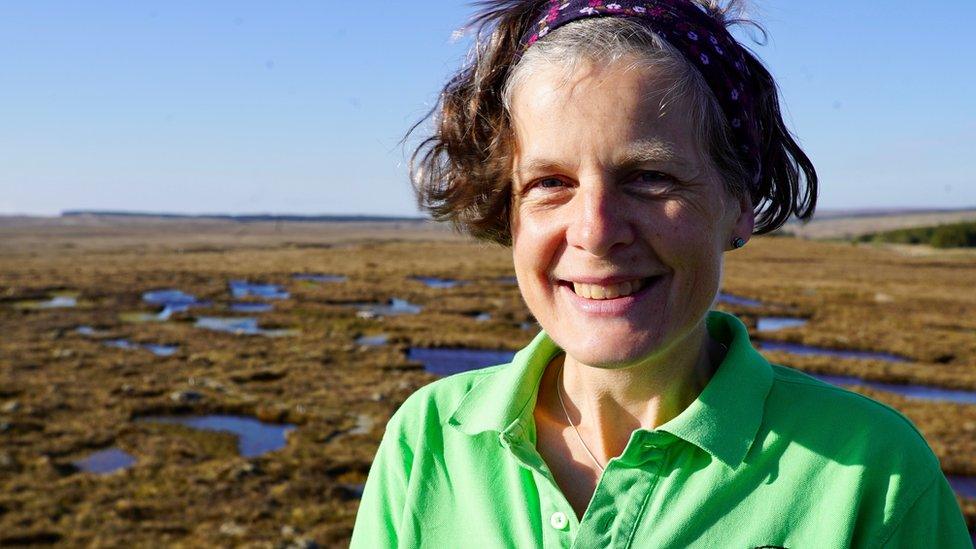
The RSPB's Caroline Eccles wants to bring the delights of the Flow Country to a wider audience.
Crouching down she points out the most important plant in this process, the spongy, springy, multi-coloured sphagnum moss. Not for nothing is it nicknamed the bog builder.
Ms Eccles says she is thrilled to be involved with the fringe show, which she thinks will bring the delights of the flow country to a wider audience.
"We're hoping that it gives new insights and new ways of looking at the landscape," she says.

Sphagnum moss is known as the bog builder
It will be educational too. Dr Andersen says spreading awareness of the bog's importance in tackling climate change is vital, especially given the history of what many scientists regard as ill-judged political decisions which hampered that effort.
In the 1980s celebrities such as the late broadcaster Sir Terry Wogan and snooker player Steve Davis were encouraged by Margaret Thatcher's Conservative government to write off earnings against tax by investing in tree plantations on the bog, external.
As the money poured in, hundreds of thousands of non-native species were planted with the aim of creating jobs and boosting forestry.
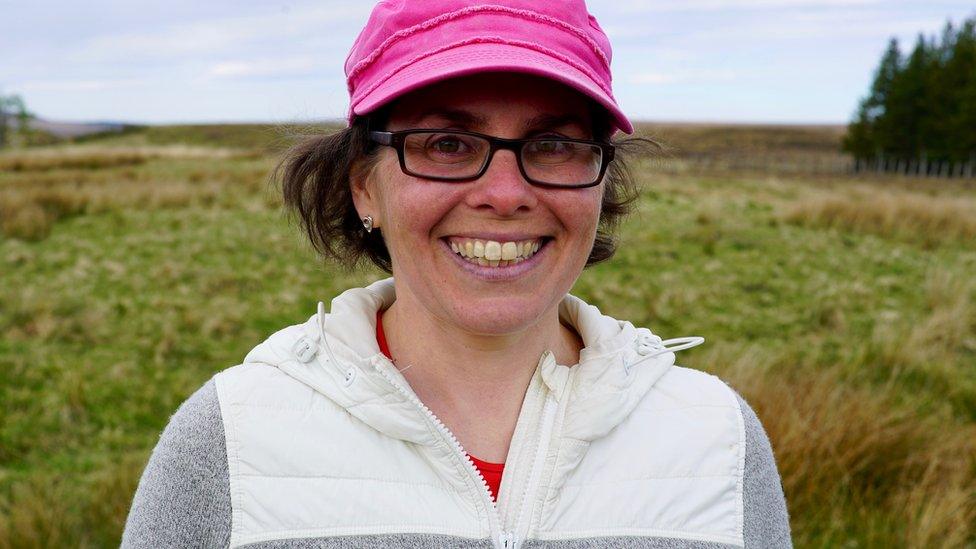
Dr Roxane Andersen says forestry schemes damaged the bog's ability to store carbon dioxide
The scheme was not a success says Dr Andersen. In fact she has published evidence that it seriously damaged the bog's ability to store carbon dioxide.
Disturbing the peatlands, whether by planting trees then or by the threat of drainage and evaporation as temperatures rise now, risks the loss of carbon "at a much faster rate than it's been accumulated," she warns.
"Effectively it could fuel climate change rather than mitigate it," she says.
Aware of that risk, the RSPB has been leading efforts to clear the forest and return the bog to pristine condition.
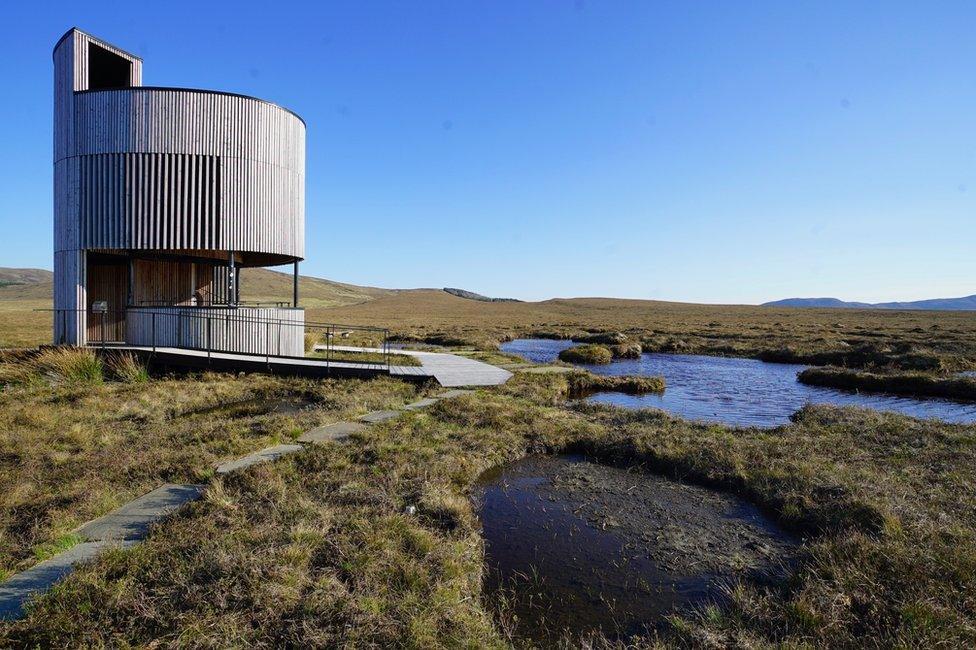
The RSPB has built a field centre and observation tower at Forsinard
The charity's work and its decision to build a field centre and observation tower at Forsinard, some 15 miles from the northern tip of Great Britain, has at times attracted controversy.
Fading graffiti on a large shed near the centre reads "No to RSPB plans".
The RSPB insists that since the tower opened in 2015 opposition has faded.

Now conservationists are working not just to fell trees but to raise the water level by damming forestry drains and furrows.
They were encouraged by research recently published by Dr Andersen which concluded that, with carefully-managed deforestation, the bog can return to its natural state as a carbon sink within about 15 years.
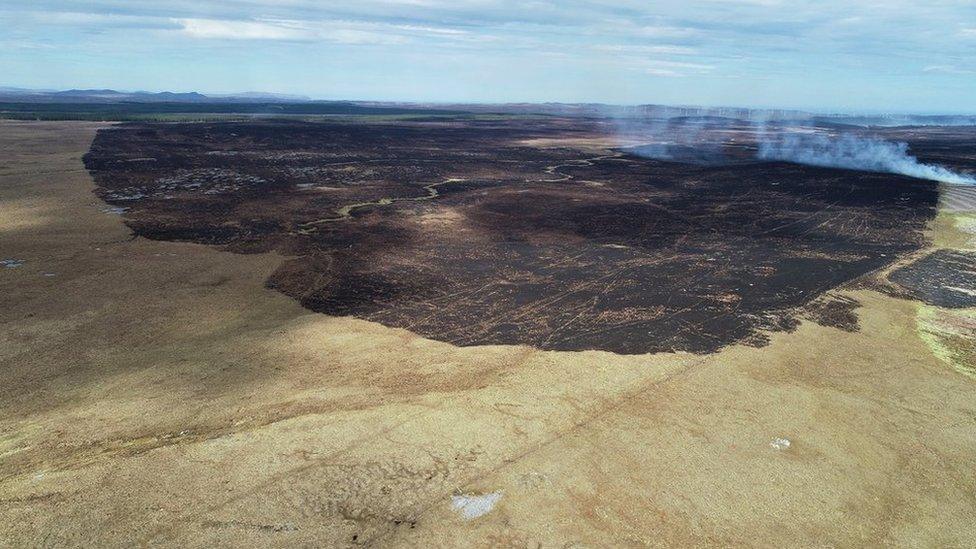
The aftermath of the wildfire on an area of Forsinard Flows
Still, Dr Andersen frets that a drought which hit the area last summer - there have even been serious wildfires here - is a harbinger of what is to come, drying out the peatland in spite of the efforts to preserve it.
"That could be really serious," she says, stressing the urgency and importance of the conservation work on the moorlands or mires as they are also known.

"If we can get them to be in the state where they can be wet and have the right type of vegetation again then they might be much more resilient to these droughts and changes in climate pattern," says Dr Andersen.
Succeeding, she says, is "absolutely critical".
- Published13 November 2018
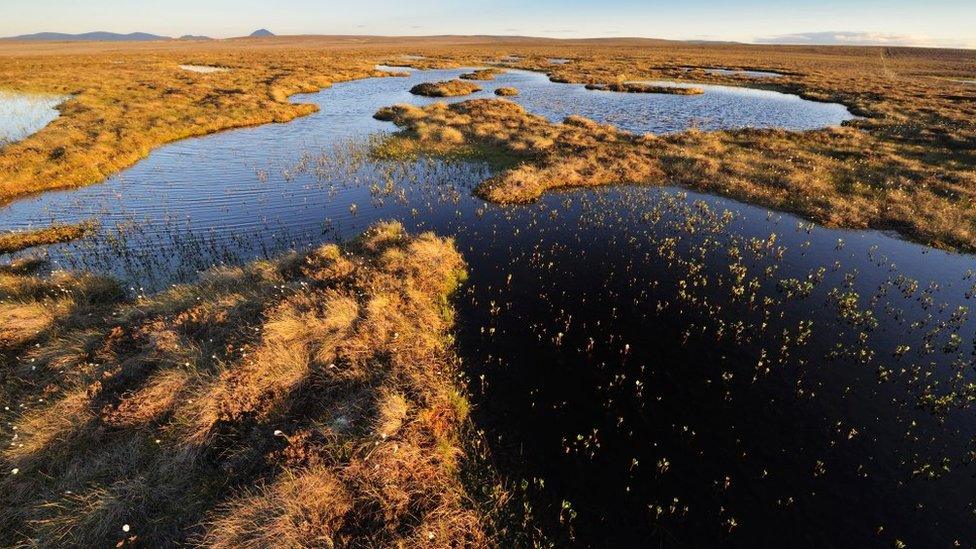
- Published22 May 2019
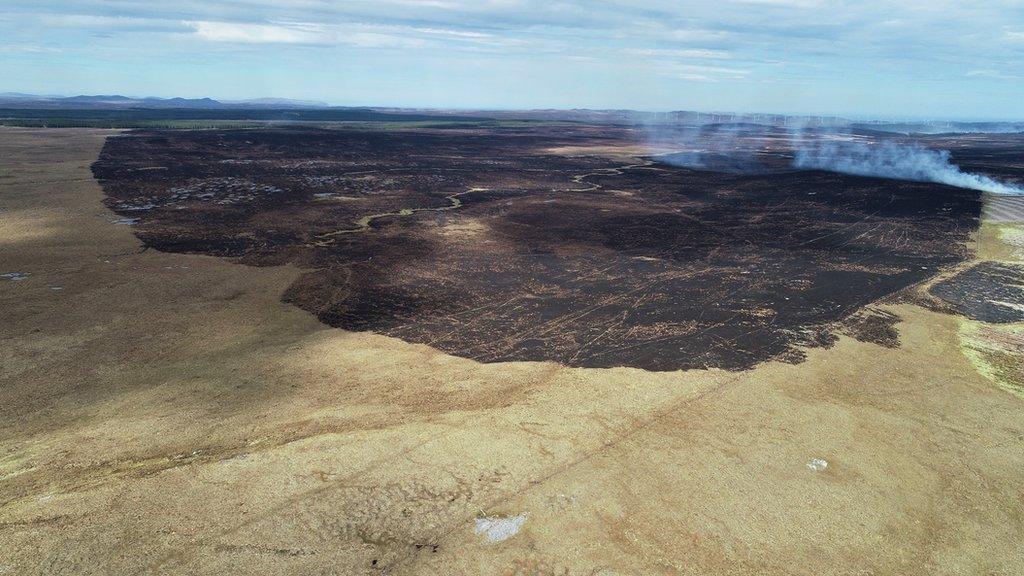
- Published2 May 2019

- Published16 March 2017
